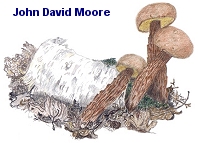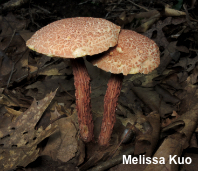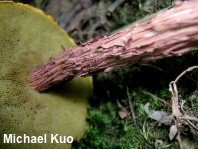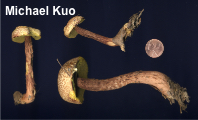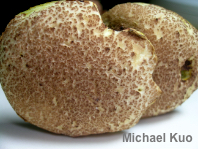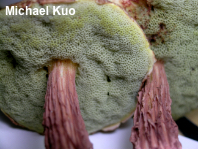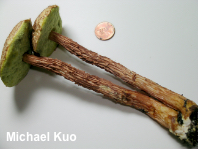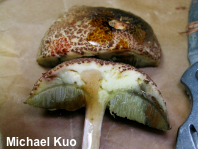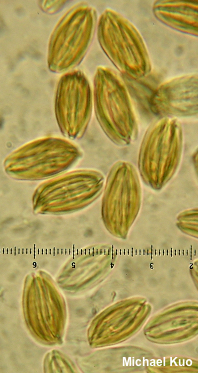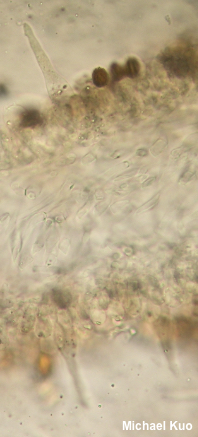| Major Groups > Boletes > Pitted/Ridged-Spored Boletes > Aureoboletus russellii |

|
Aureoboletus russellii [ Basidiomycota > Boletales > Boletaceae > Aureoboletus . . . ] by Michael Kuo This striking bolete is widely distributed east of the Rocky Mountains, where it appears under oaks and other hardwoods—and, west of the Rockies, it makes an appearance in Arizona. It features a long and skinny, shaggy, coarsely pocketed stem, along with a yellow pore surface and a dry cap; these features will separate it from most look-alikes. Although microscopic examination is probably not needed to identify Aureoboletus russellii with confidence, it is worth your time (if you enjoy such things), since its spores are profoundly ridged and very cool. Heimioporus betula is somewhat similar, but its cap is sticky when fresh and its stem is initially yellow; under the microscope its spores are finely pitted, rather than ridged. Boletus russellii and Boletellus russellii are previous names. Description: Ecology: Mycorrhizal with oaks and other hardwoods (also sometimes reported under conifers); growing alone, scattered, or gregariously; summer and fall; widely distributed in North America east of the Rocky Mountains, from the northeast to the upper Midwest and the southeastern United States, through Texas into Mexico; also found in southern Arizona. The illustrated and described collections are from Illinois and Michigan. Cap: 2–6 cm; convex, becoming broadly convex; dry; bald, but often becoming finely cracked with age and eventually becoming sub-scaly, with whitish to yellowish or pale tan flesh exposed between the cracks; dull reddish brown to pinkish brown. Pore Surface: Yellow, becoming olive yellow; sometimes depressed at the stem by maturity; not bruising, but sometimes discoloring and spotting a little brownish in places; 1–2 angular pores per mm at maturity; tubes to 1.5 cm deep. Stem: 10–15 cm long; 1–2 cm thick; gradually tapered to apex; coarsely and deeply pocketed-reticulate; dry overall, but a little sticky at the base when fresh; reddish brown; basal mycelium white. Flesh: Pale yellow in cap and upper stem; yellowish to pinkish or reddish in lower stem; not staining on exposure, or turning slightly pinkish under the cap cuticle. Odor and Taste: Not distinctive. Chemical Reactions: Ammonia purplish red to red on cap; negative on flesh. KOH dull orange to negative on cap and flesh. Iron salts negative to gray on cap and flesh. Spore Print: Olive. Microscopic Features: Spores 16–20 x 8–12 µm; more or less ellipsoid; deeply longitudinally ribbed 10–16 times, with ribs extending at each end to create the impression of either a semi-truncated end or an end with a scooped-out channel; ribs creating a stellate appearance in end view; golden in KOH. Tube trama semigelatinized. Basidia 4-sterigmate; 30–35 x 12.5–15 µm; abruptly clavate. Hymenial cystidia 40–90 x 5–15 µm; fusiform to lageniform, with apices tapered and subacute (more rarely subclavate); smooth; thin-walled; hyaline to yellowish in KOH. Pileipellis a trichoderm of often-agglutinated elements 7.5–15 µm wide, smooth, septate, golden to orangish golden in KOH; terminal cells with subclavate or merely rounded apices. REFERENCES: (Murrill, 1938) Halling, 2015. (Coker & Beers, 1943; Singer, 1945; Snell & Dick, 1970; Smith & Thiers, 1971; Grund & Harrison, 1976; Smith, Smith & Weber, 1981; Weber & Smith, 1985; Arora, 1986; Phillips, 1991; Lincoff, 1992; Both, 1993; Horn, Kay & Abel, 1993; Barron, 1999; Bessette, Roody & Bessette, 2000; McNeil, 2006; Kuo, 2007; Kuo & Methven, 2014; Halling et al., 2015; Bessette, Roody & Bessette, 2016; Woehrel & Light, 2017; Baroni, 2017; Ayala-Vásquez et al., 2018; Sturgeon, 2018; Zhang et al., 2019; Kuo & Ortiz-Santana, 2020.) Herb. Kuo 09039408, 08240505, 07120704, 09150718, 07151501. This site contains no information about the edibility or toxicity of mushrooms. |
© MushroomExpert.Com |
|
Cite this page as: Kuo, M. (2020, February). Aureoboletus russellii. Retrieved from the MushroomExpert.Com Web site: http://www.mushroomexpert.com/aureoboletus_russellii.html |
